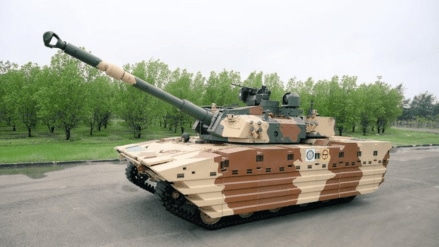In a significant development for the Indian Army, the Defence Research and Development Organisation (DRDO) and Larsen & Toubro (L&T) are nearing the final stages of trials for the indigenous Light Tank Zorawar. This new tank aims to enhance the operational capabilities of Indian forces stationed along the challenging terrains of the Line of Actual Control (LAC) in Ladakh, where tensions with China have been high.
Project Zorawar: Addressing the Need for Light Tanks
The need for light tanks became evident during the 2020 standoff with Chinese troops in Eastern Ladakh. The Indian Army had to deploy its heavier T-72 and T-90 tanks, which are not ideally suited for high-altitude areas. Recognizing this gap, the Army initiated Project Zorawar, aiming to induct approximately 350 light tanks weighing around 25 tonnes. These tanks are designed for rapid deployment and manoeuvrability in mountainous regions, providing the same firepower as regular tanks but with enhanced mobility and situational awareness.
Key Features and Capabilities
The Zorawar tanks are equipped with advanced technologies such as artificial intelligence (AI), integration of tactical surveillance drones, loitering munitions, and an active protection system. These features ensure a high degree of situational awareness and protection against anti-tank guided missiles and projectiles. Additionally, the tanks are amphibious, making them versatile for operations in riverine regions and even across the Pangong Tso Lake in Eastern Ladakh.
Development and Trials
L&T proposed the concept of a light tank to DRDO in 2021, and the project has progressed rapidly, marking one of the fastest development phases for such a product in India. The Narendra Modi government approved the indigenous design and development of these tanks in March 2022. The DRDO chief, Dr. Samir V Kamat, recently reviewed the progress at L&T’s plant in Hajira, Gujarat, where the tank was developed in a record time of two years.
The Zorawar tanks have undergone initial track trials, and upgrades were made based on the feedback received. They are now set for desert trials in coordination with the Army, followed by trials in the high-altitude areas of Ladakh. If all goes well, the tanks could be inducted into the Indian Army by 2027.
Operational Advantages
The induction of the Zorawar tanks will significantly bolster the Indian Army’s capabilities in high-altitude warfare. The lightweight and agile design of these tanks will allow for better manoeuvrability and quick deployment in the limited spaces of mountainous terrains. This mobility, coupled with advanced firepower, will enable the Army to effectively counter the Chinese deployment of similar armoured columns along the LAC.
Historical Context and Future Prospects
The Indian Army has a history of employing light tanks in various battle engagements, including the Stuart tanks during the Battle of Kohima in World War II and the PT-76 tanks in the Indo-Pak War of 1971. The success of these deployments highlighted the strategic advantage of light tanks in certain combat scenarios. However, the focus shifted to heavier tanks over the years, and the light tanks were eventually phased out.
The ongoing modernization of the Indian Army’s armoured wing, driven by the lessons learned from past conflicts and the current geopolitical landscape, underscores the urgency of developing indigenous light tanks. The Zorawar tanks, named after the legendary military general Zorawar Singh Kahluria, are expected to fill this critical gap.
Strategic Importance
The deployment of Zorawar tanks is crucial in maintaining operational dominance over adversaries like China and Pakistan, both of which have already inducted technologically advanced tanks. The indigenous development of these tanks aligns with India’s strategic goals of self-reliance and technological advancement in defence. Moreover, the ongoing Russia-Ukraine conflict has disrupted global supply chains for defence components, further emphasizing the need for India to develop and maintain its own indigenous fleet of light tanks.
Need for Light Tanks in High-Altitude Warfare
During the 2020 standoff in Ladakh, the Indian Army faced significant challenges deploying heavier tanks like the T-90 and T-72 in the high-altitude regions. These tanks, weighing between 40-50 tonnes, are more suitable for plains and deserts. The need for a lighter, more manoeuvrable tank that could operate effectively in the rugged and limited spaces of high-altitude areas became clear.
Specifications and Requirements
The Army’s technical specifications for the Zorawar tank include a weight of 25 tonnes, with a margin of 10%, ensuring it can be transported by air, road, or water without difficulty. The tank must be all-weather capable and able to target various threats, including other tanks, armoured vehicles, UAVs, and precision-guided munitions. Additionally, the tank’s dimensions should not hinder its transportation by C-17 class transport aircraft, which can carry two tanks simultaneously.
Integration of Advanced Technologies
The Zorawar tanks will feature advanced technologies to enhance their combat capabilities. Artificial intelligence will be integrated for better target acquisition and decision-making. Tactical surveillance drones will provide real-time situational awareness, while loitering munitions will add to the tank’s offensive capabilities. An active protection system will safeguard the tank from incoming threats, significantly improving its survivability on the battlefield.
Historical Deployments of Light Tanks
The Indian Army has successfully deployed light tanks in several key engagements in the past. During the Battle of Kohima in World War II, Stuart tanks played a crucial role. In the Indo-Pak War of 1947-48, light tanks were instrumental in the battles at Naushera, Jhangar, Rajauri, and most notably at Zoji La. The AMX-13 tanks were deployed at Chushul and Bomdila in 1962 and at Chamb in 1965. The amphibious PT-76 tanks led the advance to Dacca during the 1971 war, showcasing the versatility and effectiveness of light tanks in diverse combat scenarios.
